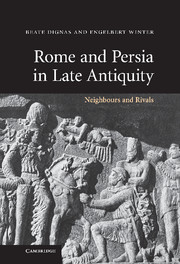Book contents
- Frontmatter
- Contents
- List of figures
- List of maps
- Preface
- Abbreviations
- Introduction: West and East, friend and foe, counterpart and mirror image …
- PART I NARRATIVE
- PART II SOURCES AND CONTEXTS
- 1 Political goals
- 2 Warfare
- 3 Military confrontations
- 4 The diplomatic solutions
- 5 Arabia between the great powers
- 6 Shared interests: Continuing conflicts
- 7 Religion: Christianity and Zoroastrianism
- 8 Emperor and King of kings
- 9 Exchange of information between West and East
- Appendix 1 Lists of Sasanian kings and Roman emperors
- Appendix 2 Chronological table
- Appendix 3 Glossary
- Bibliography
- Index of sources
- Index of translated sources
- Index of names
- Index of place names
- General index
5 - Arabia between the great powers
Published online by Cambridge University Press: 05 June 2012
- Frontmatter
- Contents
- List of figures
- List of maps
- Preface
- Abbreviations
- Introduction: West and East, friend and foe, counterpart and mirror image …
- PART I NARRATIVE
- PART II SOURCES AND CONTEXTS
- 1 Political goals
- 2 Warfare
- 3 Military confrontations
- 4 The diplomatic solutions
- 5 Arabia between the great powers
- 6 Shared interests: Continuing conflicts
- 7 Religion: Christianity and Zoroastrianism
- 8 Emperor and King of kings
- 9 Exchange of information between West and East
- Appendix 1 Lists of Sasanian kings and Roman emperors
- Appendix 2 Chronological table
- Appendix 3 Glossary
- Bibliography
- Index of sources
- Index of translated sources
- Index of names
- Index of place names
- General index
Summary
After the foundation of the Sasanian Empire in the year 224 the two powers had to deal with and administer an Arab world that was divided into three different groups. The first group was the Arab population in the Sasanian Empire, who had already lived in the Parthian kingdom during the Arsacid period and who now inevitably formed part of the Sasanian Empire. They settled in the eastern coastal area of the Persian Gulf, in northern Mesopotamia, where the desert fortress Hatra was the most important centre (map 1) and in southern Mesopotamia, where Hīra, which was located c. 100 miles to the west of the Sasanian capital Ktēsiphōn on the edge of the Arabian desert, had become a new centre (map 2). The second group comprised the Arab population in the Roman Empire, and the third group was formed by the Arabs who lived beyond the Sasanian and Roman territories on the Arabian Peninsula.
The following events and developments illustrate an ‘Arabia policy’ of the great powers that remained an important component of the foreign relations between Rome and the Sasanian Empire into the seventh century and that both powers designed in a similar way: the inhabitants of Hatra joining the Rome side after 224, the ambitious political activities of the trade metropolis in the Syrian desert, Palmyra, and finally the creation of a system of Arab vassal states.
Hatra
During the course of the Roman imperial period one caravan route, which took travellers through the steppes of central Mesopotamia to the north and via Singara and Edessa to Zeugma and the river Euphrates, became exceptionally popular.
- Type
- Chapter
- Information
- Rome and Persia in Late AntiquityNeighbours and Rivals, pp. 152 - 172Publisher: Cambridge University PressPrint publication year: 2007



